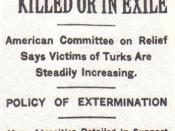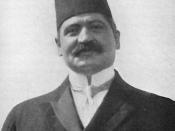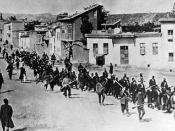The German Holocaust and the Armenian Genocide: two interconnected examples of crimes against humanityHistory contains many examples of glorious and memorable events that remind one of the greatness of the human mind and inspire him or her to pursue his or her own dreams. Nevertheless, it is also full of horrific events and monstrous doings such as genocides that reflect the darkest corners of human nature. As postulated by the 1948 United Nations Convention on the Prevention and Punishment of the Crime of Genocide, "a genocide is any of the following acts committed with intent to destroy, in whole or in part, a national, ethnical, racial or religious group, as such: killing members of the group; causing serious bodily or mental harm to members of the group; deliberately inflicting on the group conditions of life, calculated to bring about its physical destruction in whole or in part; imposing measures intended to prevent births within the group; [and] forcibly transferring children of the group to another group (15)."
Two such events are the German Holocaust and the Armenian Genocide. The German Holocaust was the destruction of European Jews during World War II, as part of a program initiated by Adolf Hitler in Nazi Germany. The Armenian Holocaust, on the other hand, is used to denote the deliberate and systematic extermination of the Armenian population of the Ottoman Empire during and after World War I. Although separated in history by more than two decades, these two atrocities are not only extremely similar in terms of methods and reasons, but also one of them partly inspired the other.
These two examples of crimes against humanity are extremely alike. Both were carried out because of racial and/or religious prejudices and political schemes. The Holocaust and the Armenian Genocide both employed methods such as...


